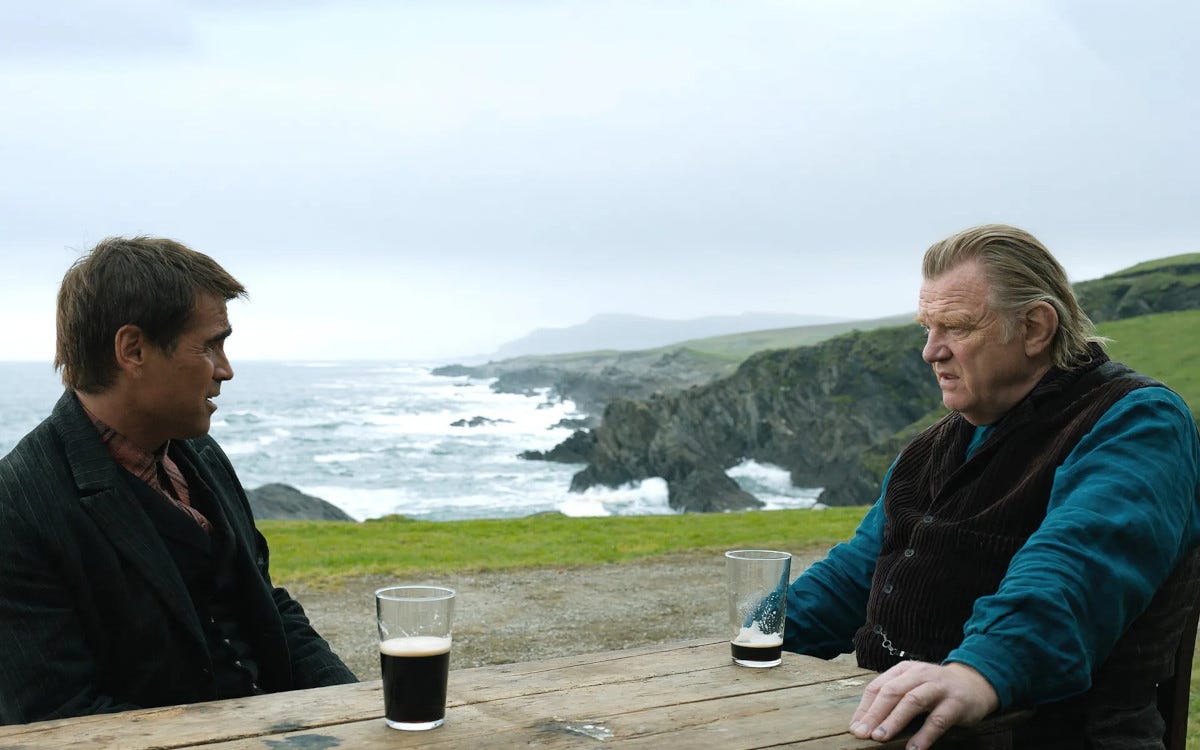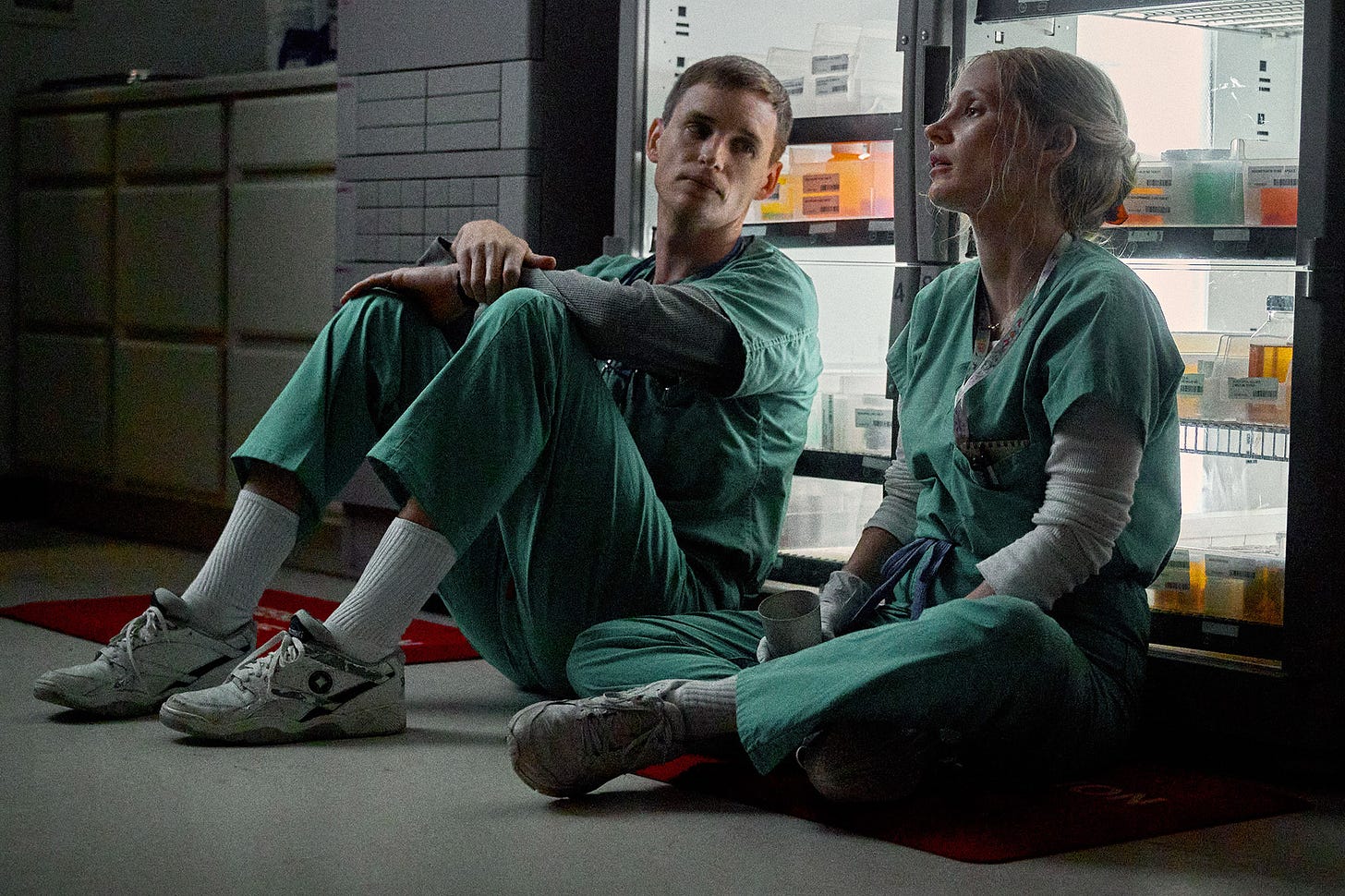In Review: 'The Banshees of Inisherin,' 'Descendant,' 'The Good Nurse'
In theaters: a pair of fighting Irishmen. At home: a couple of quality films arrive on Netflix. It's a cornucopia of choices and Thanksgiving is still weeks away.
The Banshees of Inisherin
Dir. Martin McDonagh
114 min.
A civil war has broken out in Ireland, though that’s not obvious on the island of Inisherin, a picturesque community off the coast of the mainland. Sure, you can sometimes hear the gunpowder exploding in the distance, but it’s not really clear who’s on top and who’s on bottom of the conflict. The sadistic local cop Peadar Kearney (Gary Lydon) talks of venturing ashore to participate in the hangings, but he’s not entirely clear who he’ll be helping put to death, only that the other side is paying. All that seems far away when the film opens, however, as Pádraic (Colin Farrell), a milk farmer, makes his way through town without a seeming care in the world, on his way to pay his daily visit to his best friend Colm (Brendan Gleeson) and from there off to the pub. It’s all Pádraic knows of life and all he wants to know.
But he’ll soon learn a painful lesson when Colm announces their friendship is over, a sudden shift Pádraic never saw coming and cannot explain. Even Colm doesn’t have much of an explanation. He later offers some concrete reasons — Pádraic is dull and, as a skilled fiddler and songwriter, Colm would like to use the time to focus on his music — but these sound like justifications after the fact. Still, he knows it’s over and to prove his point, Colm tells Pádraic that if he doesn’t leave him alone he’ll start cutting off his own fingers.
Then he does, which is when the latest (and best) film from Martin McDonagh (In Bruges; Three Billboards Outside Ebbing, Missouri) tips fully into the dark side of the dark comedy equation. The setting is specific — Ireland, 1923 — but Pádraic and Colm seem to be locked into an unbreakable cycle of repetition and self-destruction out of a play by Samuel Beckett (another dark-humored Irishman). Pádraic can’t leave Colm alone no matter how deep his former friend’s resoluteness goes. Colm is determined to be a man of his word to the end, maybe the very end.
All the while, a wide war wages around them, but if Banshees resists being reduced to an allegory, it certainly plays like a film about more than just two men in a quarrel. Though soulfully played by Gleeson and Farrell in a pair of remarkable performances, Colm and Pádraic are recognizable Irish types — the gloomy artist and the contented man of the country — and their conflict at times feels like a struggle for the identity of the nation itself. The film resists an easy read but invites viewers to savor the details of both its central relationship and of the characters around Colm and Pádraic, like Dominic (Barry Keoghan), an abused, dull-witted boy who becomes Pádraic’s hanger-on, and Siobhán (Kerry Condon), Pádraic’s well-read sister, who comes to suspect there’s no future for her on Inisherin. This possibility seems never to have occurred to Colm and Pádraic even as their countrymen kill each other heading into a tomorrow that may have no room for either of them. — Keith Phipps
The Banshees of Inisherin is now playing in theaters.
Descendant
Dir. Margaret Brown
109 min.
In the process of making The Order of Myths, her superb 2008 documentary about the queens of two separate, segregated Mardi Gras organizations, director Margaret Brown discovered a link between the two so remarkable that a screenwriter wouldn’t dare write a fiction so tidily. The ancestors of the white Mardi Gras queen had commissioned the slave ship that brought the Black queen’s great-grandfather to America in 1859. The circumstances under which the schooner, called the Clotilda, was brought to Mobile, Alabama were particularly odious, since Congress had forbidden human transport by that time and the trafficker, Timothy Meaher, had taken brazen steps to circumvent the law and destroy the evidence. The Clotilda was the last known slave ship to bring enslaved Africans to America, and it was likely buried at the bottom of the Mobile River.
With Descendant, Brown continues to tell, in engrossing and multi-layered terms, the same type of story that unfolded in The Order of Myths— the historic and ongoing racial tension in the Deep South, the present legacies of slavery, and the way society processes the past by denying it or siloing it off. When the Clotilda is finally discovered exactly where its captain claimed to have burned and sunk it, it’s the very definition of a bittersweet moment for the Black community that had invested so much hope in its recovery. There’s tremendous meaning and emotion connected to the tactile presence of a ship that once carried the ancestors who would later create Africatown, the enclave in which many of the film’s subjects still live. But there’s a reckoning that goes along with it, too, a shared sense that the agonies of the past must be addressed in the present. That’s a much harder conversation to have.
Brown takes her time setting the stakes in Descendant, introducing key players in the community and establishing the injustices that have persisted in Africatown since the ship arrived. The conservative white politicians who cheer the discovery of the Clotilda are also the ones who have zoned Africatown for major industry pollutants, like chemical and logging plants. The ship’s discovery sparks an outpouring of emotion, validating the stories its passengers’ descendants have been telling for generations. But there’s also legitimate concern about how this piece of history will be treated, because it’s easy to tuck the Clotilda into a museum for people to marvel at—okay, not that easy, because exhuming the ship is a formidable challenge—but addressing the historic costs via reparations is a bridge too far politically.
Brown, a white woman, has the self-awareness not merely to put Black voices at the center of Descendant, where they obviously belong, but to subtly underline those moments when white people step up and intervene in the situation—sometimes as allies and advocates, sometimes to stake their own claim. Even at the official celebration of the Clotilda’s discovery, one of the subjects worries that “our history [will] be taken the same way our people were taken.” There’s a sense of foreboding that dominates the film, as Africatown, a place literally surrounded by toxicity on all sides, prepares once again to turn inwards. — Scott Tobias
Descendant is now playing on Netflix
The Good Nurse
Dir. Tobias Lindholm
121 min.
The Danish screenwriter and director Tobias Lindholm—one of the world most renowned Tobiases—made his debut feature with the fine hostage thriller A Hijacking, which happened to come out within a year of Captain Phillips, a Hollywood version of a similar scenario where Somali pirates seize a merchant ship. The difference between the two films is meaningful: Where Captain Phillips emphasizes the personal, visceral tension between Tom Hanks’ captain and the pirates’ leader, A Hijacking takes a more detached approach, going inside a corporate office where executives mull over the negotiations. Human life may be considered precious, but the company nonetheless imposes a rigorous cost-benefit analysis on the process that endangers the captives more every passing minute.
Lindholm takes the same approach to The Good Nurse, a sobering thriller that’s ostensibly about a serial killer, but more concerned about the healthcare system that allowed him to operate for 15 years before he was finally brought to justice. It’s another case with life-or-death stakes where the most valuable life of all is institutional. Forget the Hippocratic oath: If you take seriously the possibility of an employee deliberately murdering patients, is it really worth opening a Pandora’s Box of lawsuits and criminal inquiry? Better to just close your eyes, cut your mortal losses and foist the problem on another hospital.
Written by Krysty Wilson-Cairns, who recently co-scripted films for Edgar Wright (Last Night in Soho) and Sam Mendes (1917), the film focuses on an actual good nurse, Amy Loughren (Jessica Chasten), who is grappling secretly with her own health problems. A single mother of two, Amy turns in long shifts at Parkfield Memorial Hospital in New Jersey in 2003, but hasn’t yet qualified for the insurance coverage that could remedy a potentially fatal heart condition. Relief comes in the taciturn form of Charlie Cullen (Eddie Redmayne), an experienced nurse who offers her immediate relief on her shift and takes care of her on a sly when she has an episode. Amy and Charlie work in the ICU, where deaths are not uncommon, but a couple of cases arouse suspicion about medication errors and Amy’s trust in her new colleague starts to wane.
Lindholm isn’t the type of director who’s inclined to goose up the suspense, which is not to say that The Good Nurse isn’t humming with it. Rather than create setpieces around Charlie’s misdeeds or the sudden dangers that face Amy when she catches wind of them, Lindholm turns the film into an insinuating mood piece, swamping the film in night-shift under-lighting and allowing the situation itself to amplify the stress. The problem facing Amy and the detectives trying to work around stonewalling administrators is that they’re certain of Charlie’s guilt, but don’t have any appealing options to stop him. With her heart fluttering with nerves, Amy has to pretend she doesn’t know a terrible secret, all while continuing to harbor another secret that threatens her job and her life. Lindholm doesn’t need to overemphasize any of these details.
That instinct to underplay leads to the film’s one nagging problem, which is Redmayne’s curiously mannered performance as Charlie. The real-life Cullen’s motives have never been understood, so perhaps that accounts for Redmayne’s decision to play him as hollow and detached, as if he’s a man who genuinely doesn’t know why he kills the people who rely on his care. His eruptions are unpersuasive when they happen, and the behavior leading up to them feels like the actorly version of a disturbed person—a missed opportunity at a role similar to, say, Brian Cox’s superb Lecktor in Manhunter.
Yet The Good Nurse survives its killer because it deliberately tucks him in the background as much as possible, like a boogeyman hiding in a system full of shadows. If the numbers are to be believed—Cullen confessed to killing 13 patients, but the actual figure could be in the hundreds—the film is about the most prolific serial killer in history, but Lindholm doesn’t marvel at his handiwork so much as the twisted incentives of his employers to look the other way. Lindholm and Wilson-Cairns bring Amy under the same healthcare umbrella, noting how common it is for sick people, even those working at a hospital, to court death in the face of medical expenses. That’s a more silent killer than Charlie. — Scott Tobias
The Good Nurse is now playing on Netflix











If McDonagh wants to keep directing Gleeson and Farrel in new movie every couple of years, me not would complain.